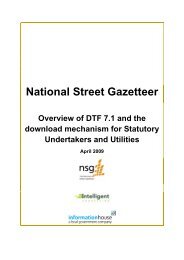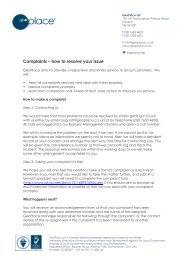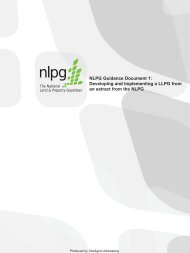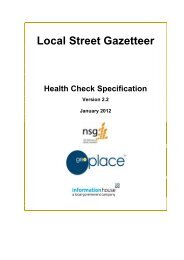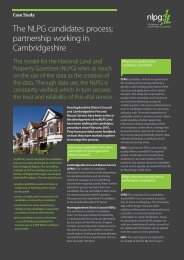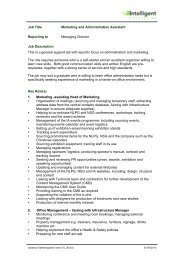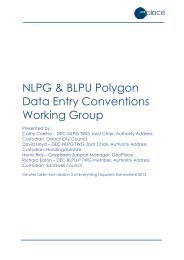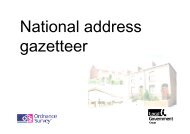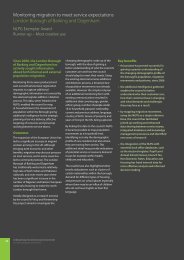You also want an ePaper? Increase the reach of your titles
YUMPU automatically turns print PDFs into web optimized ePapers that Google loves.
<strong>Local</strong> <strong>L<strong>and</strong></strong> <strong>and</strong> <strong>Property</strong> <strong>Gazetteer</strong>Data Entry ConventionsNLPG Technical Working Party2001Version : 4Date: 18/02/05 Page 1
CONTENTS1. INTRODUCTION1.1 Background1.2 Source documents1.3 Contributors1.4 Interpretation2. STREETS2.1 Introduction2.2 What is a Street?2.3 Street Types2.4 To which street should a BLPU be assigned?2.5 Interpretative Issues3. BASIC LAND & PROPERTY UNITS (BLPUs)3.1 Introduction3.2 Definition of a BLPU3.3 Provenance3.4 Chronology of BLPUs3.5 Other BLPU Issues3.6 Linked Business Applications4. LAND & PROPERTY IDENTIFIERS (LPIs)4.1 Introduction4.2 Additional Information4.3 Typography5. HIERARCHICAL RELATIONSHIPS5.1 Introduction5.2 Logical Status issues in parent-child relationships5.3 General Rules5.4 ExamplesAPPENDICESA. Source DocumentsB. List of ContributorsC. Chronology of BLPUsD. Identifying non-addressable objectsE. Procedure for Producing a Formatted Postal Address from a <strong>L<strong>and</strong></strong> &<strong>Property</strong> IdentifierVersion : 4Date: 18/02/05 Page 2
Version : 4Date: 18/02/05 Page 3
1. INTRODUCTION1.1 Background1.1.1 The conventions outlined in this document have been determinedhaving regard to the advice contained within a number of publications,<strong>and</strong> in the light of the practical experience gained during 1999 – 2001by a group of <strong>Local</strong> Authorities in creating their <strong>Local</strong> <strong>L<strong>and</strong></strong> & <strong>Property</strong><strong>Gazetteer</strong>s (LLPG) for submission to the National <strong>L<strong>and</strong></strong> & <strong>Property</strong><strong>Gazetteer</strong> (NLPG) Hub. The aim of this publication is to assistpractitioners in the creation of their data-sets, <strong>and</strong> will lead to greaterconsistency in practice across the United Kingdom.1.1.2 This document has been approved by the NLPG Technical WorkingParty, which is a group established by the Improvement &Development Agency (IDeA) to assist in the creation <strong>and</strong> maintenanceof the NLPG data-set. The Group consists of volunteers, mainly from<strong>Local</strong> Authorities involved in LLPG creation <strong>and</strong> maintenance, togetherwith representatives from IDeA <strong>and</strong> Intelligent Addressing (IA), thecontractor responsible for initially building the NLPG Hub.1.1.3 The contributors to this document have therefore taken account of boththeoretical <strong>and</strong> practical issues.1.1.4 Cross references to the relevant sections of BS 7666 are included withinthe various sections of this document, in italic type at the right h<strong>and</strong>side of the page.1.2 Source Documents1.2.1 These are listed in Appendix A.1.3 List of Contributors1.3.1 This is listed at Appendix B.1.4 InterpretationThis document is intended as best practice advice only <strong>and</strong> is not prescriptive.It does not supersede the British St<strong>and</strong>ard which should be referred to inorder to resolve issues of interpretation. Words in blue cross-refer to theNLPG general Glossary of terms.Version : 4Date: 18/02/05 Page 4
2. STREETS2.1 Introduction2.1.1 The substance of this section will form the basis of recommendations foramendments to the relevant publications relating to the creation of theNational Street <strong>Gazetteer</strong> (NSG). To be useful to practitioners it isnecessary to go further in defining a “street” than previous publicationshave sought to do, <strong>and</strong> to give some practical examples wheredifficulties in interpretation <strong>and</strong> practice may be encountered.2.1.2 The relationship between street record data held within a <strong>Local</strong> <strong>L<strong>and</strong></strong> &<strong>Property</strong> <strong>Gazetteer</strong> (LLPG) <strong>and</strong> the NSG is a subject which has causedsome difficulty in some areas; this is compounded in the two-tierAuthority scenario where the LLPG-making authority <strong>and</strong> the NSGAuthority are different. The diagram included below suggests how theflow of data should take place.Version : 4Date: 18/02/05 Page 5
Data flows for maintenance of street information in the National Street <strong>Gazetteer</strong> using <strong>Local</strong> <strong>L<strong>and</strong></strong> <strong>and</strong><strong>Property</strong> <strong>Gazetteer</strong> creation <strong>and</strong> maintenance.C<strong>and</strong>idate BLPUs<strong>and</strong> other LPG,SG issuesUsers <strong>and</strong> StatutoryUsersC<strong>and</strong>idateBLPUs <strong>and</strong>other LPG,SG issuesNational <strong>L<strong>and</strong></strong> <strong>and</strong><strong>Property</strong> <strong>Gazetteer</strong>Dailyupdate<strong>Gazetteer</strong> FunctionLLPG <strong>and</strong> <strong>Local</strong> Street <strong>Gazetteer</strong>(min level 1, possibly level 3)UPRN <strong>and</strong> USRN allocation<strong>Local</strong> <strong>L<strong>and</strong></strong><strong>and</strong> <strong>Property</strong><strong>Gazetteer</strong> <strong>and</strong><strong>Local</strong> Street<strong>Gazetteer</strong> tolevel 1 or 3 USRN withLevel 1 or 3Street<strong>Gazetteer</strong>dataNational Street<strong>Gazetteer</strong><strong>Local</strong> Street<strong>Gazetteer</strong> tolevel 1 or 3<strong>and</strong> AssociatedStreet DataHighways FunctionDailyupdateAssociated Street Data <strong>and</strong><strong>Local</strong> Street <strong>Gazetteer</strong> tolevel New 1 or or 3)changedstreets (Type2 or 3)QuarterlyupdateUSRN <strong>and</strong>UPRNDailyupdateNew orchangedproperties<strong>and</strong> streets(Type 1)New orchangedpropertiesUSRN <strong>and</strong>UPRNStreet Naming <strong>and</strong>Numbering functionOther internalproperty datasourcese.g. Council Tax <strong>and</strong>Electoral Roll.All Other <strong>Local</strong>AuthorityFunctionsVersion 1.7Version : 4Date: 18/02/05 Page 6
from which access might be gained. Sometimes more than one streetmight provide access.One can either add multiple LPI records or describe the LPI in terms ofthe primary access point. For sites not accessible to a street it isadvisable that your LPI description includes some form of reference tothis. For example "LAND BEHIND 'ANOTHER BLPU'".For rural sites use the last street listed in the Streets file which istraversed in travelling to the BLPU; in some cases this will result in anLPI which contains attributes from a street in a different “Town” from theBLPU itself.Part 2 para.7.3.32.5 Interpretative Issues2.5.1 Streets crossing administrative boundaries within a singleCouncil’s area.It is necessary that a separate record be maintained for the part of astreet falling within each discrete “town”. For example, if villages orparishes are populated into the town field, a street connecting two suchentities may have a single name for the whole of its length, but it willneed two records in the Street <strong>Gazetteer</strong>. This ensures that BLPUsassigned to each part of such a street will have the correct addressattributes.2.5.2 Village name / street name identical.In rural areas it is often the case that a village main street will bear thename of the village. This is acceptable. The problem it causes is inthe use of linked business applications, where an address label willeffectively bear the village name twice. In these cases it is suggestedthat the business application software be used to suppress the use ofthe street name. (This workaround device may also be employedwhere Type 2 street descriptions may be undesirable within linkedbusiness applications, on address labels for example.)2.5.3 Street & BLPU in different administrative areasThis is a common problem found in compiling the national data-set.Liaison with neighbouring districts is required to obtain the necessaryUSRN. This will be made easier when all local authorities join theNLPG process as this will enable them to cross reference with a copyof the NLPG. Failing this, Intelligent Addressing can provideinformation on the correct USRN to use in cases of doubt.Version : 4Date: 18/02/05 Page 8
2.5.9 Lock-up garage courtsGenerally these should be a single BLPU accessed from an existingstreet, so no new street record needs to be created, e.g. GARAGECOURT ADJACENT TO …..”. Individual garages, if captured, shouldbe created as secondary BLPUs.2.5.10 Motorway Interchanges / slip roads / service areas.A motorway junction shall include all of its slip roads. Link <strong>and</strong> sliproads are considered as part of the street to which they relate. ESUsshall be recorded for each link or slip road.Part 1 para. 4.2.32.5.11 RoundaboutsIf unnamed roundabouts shall be regarded as part of the major streetpassing through or leading to it. If named a roundabout shall have aseparate street reference. Mini-roundabouts shall be considered to bepart of the street in which they are situated. If a geographic streetcontinues on either side of a roundabout it shall be considered as asingle contiguous street, unless the street name or number changes.2.5.12 Dual CarriagewaysPart 1 para. 4.2.1These shall be considered as one street, unless the carriageways havedifferent names. ESUs shall however be recorded separately for eachcarriageway.Part 1 para 4.2.22.5.13 Attribute DataAt least one of the <strong>Local</strong>ity, Town or Admin. Area must be populated ineach record.Part 1 para. 3.2(c)2.5.14 <strong>Local</strong>ityThis attribute should only be used to resolve ambiguity or enhanceunderst<strong>and</strong>ing, for example where there are two streets within the same“Town” with the same name. The label used should be a name, whichis locally understood <strong>and</strong> meaningful.Part 1 para.5.3.2Version : 4Date: 18/02/05 Page 11
2.5.15 Co-ordinatesThese should normally be 6 figures eastings <strong>and</strong> 6 figure northings. Inthe extreme north of Scotl<strong>and</strong> 7 figures are used. Where accuracies of10m. or less are used, pad out the references to 6 figures using trailingzeroes.2.5.16 MiscellaneousPart 1 para. 2.1An unofficial street name may cover part or all of one or several streets.An individual street may have more than one gazetteer entry.Different street references may overlap.Part 1 para.2.14Version : 4Date: 18/02/05 Page 12
For example, the Council’s property portfolio can be mapped, either infull, or as a sub-set of the portfolio, by assigning values to an attribute<strong>and</strong> using a filter.The reader is recommended to study the new LLPG/NLPG DataTransfer Format v6.0a, which includes BLPU extents. The authors ofthis document intend, in due course to produce a supplement to thisdocument dealing specifically with the interpretative issues surroundingthe graphical capture of extents.3.2 Definition of a BLPU3.2.1 The reader is referred to Part 2 (as revised) of BS 7666. In generalterms a BLPU should be a permanent feature, with a polygonalfootprint, which can be identified on a large scale map.3.2.2 The following table lists some examples of features where doubt existsas to whether they should be included in the LLPG / NLPG, <strong>and</strong>recommends best practice:Version : 4Date: 18/02/05 Page 14
3.3 Provenance3.3.1 A <strong>Gazetteer</strong> shall include all BLPUs with specified provenances withina defined geographical area. A BLPU may have more than oneprovenance. Some basic rules for determining provenance are asfollows:Data Source Provenance Code<strong>L<strong>and</strong></strong>line Interpolation Inferred from physical use PTitle Deeds or similar Registered Title THMLR Registered Title Registered Title TRating or Valuation Office Inferred from OccupancyOrecords<strong>L<strong>and</strong></strong> Use Surveys Inferred from Use U3.4 Chronology of BLPUs3.4.1 New DevelopmentsPart 2 para. 4.3.5The sequence of events. This table attempts to tie the LLPG process into reallife events within a <strong>Local</strong> Authority. There is scope for a limited amount oflocal practice to be adopted in this subject area; for example, some Councilswill not wish to complete the first three tasks listed in the table. Appendix Clooks at this subject in more detail, setting out one Council’s approach to thesubject.Version : 4Date: 18/02/05 Page 16
EventLLPG ActionOutline Application Submitted Create BLPU <strong>and</strong> descriptive LPI for estate –status “provisional”. The BLPU may be locatedon a street which has not yet been constructed ornamed. A type 2 street could be created as atemporary measure, <strong>and</strong> given the same name asthe development. This will be changed to a type 1record as soon as the street naming process hasbeen completed. *Outline Planning Application ApprovedNoneOutline Planning Application RefusedAfter expiry of time for appeal, change estateBLPU <strong>and</strong> LPI status to “historic”. *Detailed Planning Application Submitted NoneDetailed Planning Application Approved Create BLPUs for each plot; use rectified scannedimages of plans to create points <strong>and</strong>/or extents;use plot numbers in LPIs if no more dataavailable. The LPIs will also have a provisionalstatus.Naming <strong>and</strong> numberingIf appropriate, create the new streets on the LPG.If the provisional LPIs were attached to a streetcreated as the development name, they should bemade historic on this street.Create new LPIs referenced to the appropriatestreet with the address information <strong>and</strong> a status of“c<strong>and</strong>idate”. * At this stage the development isnot necessarily built on the ground. Once thecomplete development has been named <strong>and</strong>numbered the street (if created) holding thedevelopment name can be closed.If the builders plans have changed some BLPUsmay have changed location <strong>and</strong> co-ordinates.Extents if created may need to be graphicallyedited. In other cases plots may have beenwithdrawn <strong>and</strong> therefore these should be rejectedfrom the LPG. Additional BLPUs may also haveto be created with a “c<strong>and</strong>idate” * status ifadditional plots have been added to thedevelopment.CompletionBLPUs <strong>and</strong> LPIs should be amended to“approved” status.If an original estate BLPU <strong>and</strong> LPI were createdthe LPI should be amended to, for example,“LAND COMPRISING DEVELOPMENTNAME”. The status for the estate BLPU <strong>and</strong> LPIshould be changed to “historic”. *OccupationNone – unless change to incorporatehouse/building name by occupier, e.g.Dunroamin,which is notified by the Street Naming <strong>and</strong>Numbering Authority.O.S. <strong>L<strong>and</strong></strong>line (or DNF in future) amended to BLPU co-ordinates may need improving <strong>and</strong>include full details of estateBLPU extents should be created or amended ifnecessary* Note: some authorities have gazetteer interfaces with business applications,which preclude the use of some status values. These will need to bediscussed with the interface designer.Version : 4Date: 18/02/05 Page 17
The database may be enhanced with additional fields; e.g. it could beuseful to include dates for commencement <strong>and</strong> completion of buildingworks – BS 7666 Part 2 Table 1 refers; or, additional information onofficial addresses could be held – BS 7666 Part 2 Table 6 refers.3.4.2 Demolished propertiesRetain the BLPU, but amend its logical status. A closure date isrequired. You must make sure that the BLPU is not deleted, forcompleteness of gazetteer <strong>and</strong> to ensure that any link to applicationdata that may be attached to the record is maintained. The St<strong>and</strong>ardstates that a <strong>Gazetteer</strong> may include BLPUs relating to any specifiedtime period, <strong>and</strong> may include BLPUs which no longer exist.3.5 Other BLPU Issues3.5.1 Representative PointPart 2 para. 3.4.3 & 4This should lie within the BLPU. However, where information is lackingthis may fall outside, but in these cases it may be given the co-ordinateof either the 100m. square containing the BLPU or the start point of thestreet.Part 2 para. 7.1.23.5.2 Assignment of BLPUs to streetsCorner sites Ask where is the access from? Some local authoritiestake the “official” address known by Street Naming <strong>and</strong> Numbering asthe gazetteer address <strong>and</strong> supplement this with others on connectingstreets as alias address information. Other suggestions/methodologiesnoted include occupier address <strong>and</strong> local/historical knowledge.For non-addressable parcels of l<strong>and</strong> the protocol to use is based uponuse of the street frontage, which is used to gain access to the l<strong>and</strong>. Ifno access point exists it is recommended that the longest frontage beused.3.5.3 Military InstallationsA <strong>Local</strong> Authority will record one BLPU for the entire site. Militaryorganisations’ application data might then fill in the individual internalBLPUs.Version : 4Date: 18/02/05 Page 18
3.5.4 Streets as BLPUsA property record for a street is required both for completeness of the<strong>Gazetteer</strong>, as required by BS 7666, <strong>and</strong> by the users of linked businessapplications. For example environmental health users will need toassign records to a street in some circumstances. Community safetyincidents or noise complaints will often be referenced to a street ratherthan individual properties within it.The PAON for a street BLPU can be defined according to locallydefined practice;- The NLPG will accept a property number of "0" for astreet BLPU.3.5.5 Villages as BLPUsA village record is not required for completeness by BS 7666. However,a record will be needed by various users of linked business applicationsas in 3.5.4.The PAON can be defined according to locally defined practice; – e.g.“VILLAGE RECORD” – not required for NLPG3.6 Linked business applications3.6.1 The primary purpose of the <strong>Local</strong> <strong>L<strong>and</strong></strong> <strong>and</strong> <strong>Property</strong> <strong>Gazetteer</strong> is tohold records for l<strong>and</strong> <strong>and</strong> property. A clear distinction needs to bemade between the LLPG <strong>and</strong> a “business application” that is linked to(but not part of) the LLPG. For example, in many <strong>Local</strong> Authorities thegazetteer is also used to hold other records such as street furniture,advertising hoardings, housing estates <strong>and</strong> separate businesses(which operate from the same LPI). It is preferable for suchinformation to be linked to the LLPG rather than held within it.3.6.2 Two examples are given. These relate to cases where there is a directrelationship between a business application <strong>and</strong> a single BLPU.Version : 4Date: 18/02/05 Page 19
Example 1 – business databaseA business database could be held separately <strong>and</strong> linked to the LLPG suchthat each business holds a single UPRN representing the BLPU within whichit exists. This would be preferable to holding business names as SAONs,which would complicate the LLPG <strong>and</strong> make it very difficult to maintain. Herethere would typically be a one to many link between the LLPG <strong>and</strong> theBusiness Database (one UPRN could have many businesses against it).One to ManyBLPUBusiness RecordBusiness RecordBusiness RecordBusiness RecordBusiness RecordExample 2 – housing database3.6.4 A database of housing estates <strong>and</strong> blocks (for service charge allocatio<strong>net</strong>c) could also be held as a separate database. This would bepreferable to holding entire housing estates as BLPUs within the LLPGpurely for attaching data against them. Here there would be a many toone relationship between the LLPG <strong>and</strong> the Housing database whereMany UPRNS would be referenced by a Single housing estate or blockrecord.Many to OneBLPUBLPUBLPUBLPUBLPUHousing BlockVersion : 4Date: 18/02/05 Page 20
4.1 Introduction4. <strong>L<strong>and</strong></strong> <strong>and</strong> <strong>Property</strong> Identifiers - LPIs4.1.1 There is a huge potential for different practices to be employed bydifferent <strong>Local</strong> Custodians interpreting BS 7666 in different ways to suitsituations encountered across the length <strong>and</strong> breadth of Engl<strong>and</strong> &Wales. This has especially been the case with non-postallyaddressable features, <strong>and</strong> a large selection of examples in thiscategory, with in many cases alternative acceptable options, isincluded at Appendix D. The advice in this section is intended toincrease the degree of consistency within the national dataset.4.1.2 In some areas rigorous Street Naming <strong>and</strong> Numbering techniques maynot have been applied, or may not have been effective. It issuggested that there may be a need, occasionally, for a pro-activeexercise to be undertaken by Street Naming & Numbering Officers torectify situations where addresses are either very confused, or wherefull address attribute data simply does not exist. Examples where thisscenario may apply are old industrial estates, or streets which passfrom one administrative area to another, where residents have overtime used different forms of postal address.4.1.3 The information included within the PAON should be selected accordingto the following hierarchy:Premise numberPremise nameBusiness nameDescriptionThe premise number <strong>and</strong>/or premise name are of equal status; if bothexist, as with a dwelling, then both should be used.Part 3 para.5.6.14.1.4 A SAON may be located within the same building as the PAON,e.g. a flat within a block, or it may be part or all of a different buildinglocated within a widely defined PAON, e.g. “OUTPATIENTS’DEPARTMENT” at “ADDENBROOKES HOSPITAL”.Part 3 para 4.1Version : 4Date: 18/02/05 Page 21
4.2 Additional Information4.2.1 Business Names.As mentioned below in section 5.5 the LLPG is not primarily designedfor storing business names, although some Authorities have sought togain the business benefit of holding such data within the LLPG, where itcan be centrally maintained. Business names are permissible where aproperty is locally known by its occupant’s name <strong>and</strong> where it has nopremises number, e.g. “HARRODS”. Otherwise it is recommendedthat business names be held in a linked database.4.2.2 House names <strong>and</strong> numbers (when both exist)The name <strong>and</strong> number will both be entered in the PAON, the number inspaces 1 – 10 <strong>and</strong> the name commencing in space 11. Where thenumber is a simple numeric it will be right justified in spaces 1-4; wherethe number has an alphabetic suffix this will be entered in space 5.Where the number is a range, e.g. 12-14, the start number will beentered in spaces 1-4, <strong>and</strong> the end number in spaces 6-9. Space 10would be used for an end number suffix.4.2.3 Adjacency conventions.The fewer the better. Duplications within the same street, e.g. “LANDADJACENT TO” must only be used once for a given street.4.2.4 Postal Addresses.There has been confusion in many areas over the subject of postaladdresses. The St<strong>and</strong>ard requires addresses to be geographicallybased; thus in many cases, especially in rural areas, LPIs will not bepostally correct. Included at Appendix E is a recommended routine forthe production of postally correct addresses from the LPI.4.3 Typography4.3.1 AbbreviationsThese shall not be used except where they form part of the officialname. The only exception is “ST” for “Saint”.Part 1 para.5.3.1Part 3 para. 6.5Version : 4Date: 18/02/05 Page 22
4.3.2 PunctuationNo punctuation shall be included within fields except apostrophes,ampers<strong>and</strong>s, hyphens <strong>and</strong> parentheses which may be used where theyare included in the official name.Part 3 para 6.54.3.3 CaseUpper case is recommended to be used throughout all records.Version : 4Date: 18/02/05 Page 23
5. Hierarchical Relationships5.1 Introduction5.1.1 This section seeks to clarify Best Practice when dealing with hierarchicalrelationships between l<strong>and</strong> <strong>and</strong> properties. The advice in this sectionrelates to the textual attributes contained within LPIs, <strong>and</strong> not the BLPUextents held within GIS. The following terms are used: -• Parent BLPU: This is a BLPU/LPI pair where the LPI contains an entryin the PAON but no entry in the SAON fields.• Child BLPU: This is a BLPU/LPI pair where the LPI contains an entry inboth the PAON <strong>and</strong> the SAON fields5.1.2 The following relationship should be enforced between the parent <strong>and</strong>child BLPU“A child BLPU can only be created where a parent BLPU already existswith the same PAON <strong>and</strong> USRN.”5.1.3 The child BLPU should therefore inherit the PAON <strong>and</strong> USRN (not thePost Code) from the parent to avoid inconsistency. This is reflected inpara 7.3.3 of BS7666 part 2. The following diagram illustrates therelationship.SingleParent BLPUManyChild BLPUsBLPU UPRN BLPU UPRN *Is different to parentLPI UPRN LPI UPRNLPI SAON *blank LPI SAON *requiredLPI PAON LPI PAON *same as Parent BLPULPI USRN LPI USRN *same as Parent BLPULPI Post Code LPI Post Code *can be different to parentLPI Etc LPI Etc5.1.4 A child BLPU cannot exist without there being a parent BLPU. Where aproperty is subdivided into two flats a third entry for the building shellmust be created first. Such “building shell” records can be flagged asnon-addressable to prevent post being sent to it where the LLPG isused for generating mailing addresses.Version : 4Date: 18/02/05 Page 24
5.2 Logical Status issues in parent-child relationships5.2.1 It is possible for a single BLPU to have multiple LPIs. The aboverelationship is enforced for a BLPU/LPI pair where the logical status ofthe LPI is 1 (approved preferred), 5 (approved alternative), 6(Provisional), 8 (Historical) or 9 (Rejected). It is possible that the childBLPU has an LPI with a different Logical status to the parent BLPUsLPI.5.2.2 BLPUs with LPIs of logical status 2 (approved alternative) or 3(Alternative) should not exist without there being a logical status 1 LPI.Any parent-child relationships should be enforced at Logical Status 1level for these BLPUs. The following examples illustrate this.5.2.3 Here we have a building which has an alternative LPI of logical status 3.Type UPRN SAON PAON Road LogicalStatusParent 500001 100 London 1BLPURoadParent 500001 Old London 3BLPUBuildings RoadChild 500002 Flat A 100 London 1BLPURoadChildBLPU500003 Flat B 100 LondonRoad15.2.4 Child BLPUs of the form Flat A, Old Buildings, London Road shouldNOT be created because these will not “relate” to the Logical Status 1LPI. The child BLPUs shown above are acceptable because they dorelate to the logical status 1 parent BLPU.5.2.5 It would also be possible to have an alternative to child BLPU 500002 ofthe form: -Type UPRN SAON PAON Road LogicalStatusChildBLPU500002 BasementFlat100 LondonRoad25.2.6 This alternative also relates to the logical status 1 parent.5.3 General rules5.3.1 Typically a whole piece of l<strong>and</strong> or a building will be a parent BLPU.5.3.2 For some l<strong>and</strong> it will be possible to subdivide it geographically into childBLPUs (for example, fields <strong>and</strong> out buildings as child BLPUs of a farm).Version : 4Date: 18/02/05 Page 25
5.4 Examples1 Suffixed PAONs7D7C7B7A2 Alpha Flat IdsExample Issue RecommendationIn this example a7house is dividedinto 4 flats whichare numbered 7Ato 7D. Typicallythere would be(a) No record for aNo 7 in manypre NLPGgazetteers.(b) A single dooraccessing allflatsFlat DFlat CFlat BFlat A3 Numeric Flat IdsFlat 4Flat 3Flat 2Flat 177Here we have asimilar situationbut where the frontdoor is 7 <strong>and</strong> flatsA to D are recordedas “Flats”.As above, but theFlats are identifiedby numeralsThat four parent BLPUs becreated with PAONs as 7A,7B, 7C <strong>and</strong> 7D respectivelyThe building shell, 7, is createdas a PAON, <strong>and</strong> four childBLPUs are created for each ofthe flats, with SAONs as FLATA, FLAT B, FLAT C, FLAT DAs above but flats are createdas FLAT 1 to FLAT 44 Descriptive Flats7Second Floor FlatFirst Floor FlatGround Floor FlatBasement Flat5 Basement Flat77AThis example istypical of manyCouncil Taxsystems, wheredescriptive flatlocations arepreferred to use offlat identifiers. Inmany cases theseflats will also haveeither alpha ornumeric identifiers.Here the basementflat may beaccessed by aseparate doornumbered as 7A.Creating “Flat A”It is recommended that wherealphabetical or numericidentifiers exist that these areused instead of descriptions.Creation of cross-references toexisting systems that use thisconvention will need to becarefully considered.Only in exceptionalcircumstances shoulddescriptive flats be added tothe LLPG.Create two parent BLPUs “7”<strong>and</strong> “7A”.Version : 4Date: 18/02/05 Page 27
6Suffixed Building7 7Aas a child BLPU of“7” may causeconfusion (mailbeing sent to No 7by mistake)Two separatebuildingsCreate two parent BLPUs “7”<strong>and</strong> “7A”.7Flats <strong>and</strong> Suffixed BuildingFlat DFlat CFlat BFlat A7 7AExample where a“Flat A” No “7”<strong>and</strong> “7A” exists.Create parent BLPUs “7” <strong>and</strong>“7A”. No “7” has four childBLPUS “Flat A” to “Flat D”8Complex BlockProspect House5-11Flats E-HFlats A-DOfficeShops 5 7 9 119Complex BlockFlat 3, 5-7Flat 2, 5-7Flat 1, 5-75A 5-7 7A10Individually Numbered Maiso<strong>net</strong>tes11102 106 110100 104 108Block on two streetsDundee MansionsFlats A-DInverness RoadFlats E-HAberdeen RoadAssume that theflats <strong>and</strong> office areaccessed by aseparate door to the4 ground floorshopsA single residentialbuilding no “5-7”which also has twoground level flatsnumbered “5A”<strong>and</strong> “7A” accessedby separate sidedoors.Example where asingle building willhave two Streetnumbers <strong>and</strong> twodoors, typicallygiving access to anupper <strong>and</strong> lowerflat or maiso<strong>net</strong>teA complexproperty where asingle block fronts<strong>and</strong> is accessed bytwo different doorsaddressed off twostreets. Thisexample breaks therelationship whichrequires the StreetCreate 5 parent BLPUs for Nos“5”, “7”, “9”, “11” <strong>and</strong> “5-11”.Create 8 child BLPUs for the“Flat A” to “Flat H” (childrenof “5-11”). The office will beassociated with the parentBLPU “5-11”Create three parent BLPUs for“5A”, “7A” <strong>and</strong> “5-7”. Createthree child BLPUs for “Flat 1”to “Flat 3” off “5-7”Create each pair as two parentBLPUs. No child BLPUs.Create two parent BLPUs forDundee Mansions, one foreach street. Create four childBLPUs off each parent for theflats.Note that in some cases it ispossible for “DundeeMansions” to exist twice incompletely different parts ofVersion : 4Date: 18/02/05 Page 28
12Flats over shops27C Flat C27B Flat B27A Flat A27 29<strong>and</strong> PAON to bethe same betweenparent <strong>and</strong> childBLPUsFlats accessed by aside door locatedover shopsthe local Authority area ondifferent streets. This exampleis treated no differentlyIf a single door gave access toall flats, then a single parentBLPU would be created.Create PAONs for 27, 27A,27B <strong>and</strong> 27C. Create parentBLPU for “29”. Create threechild BLPUs “FLAT A” to“FLAT C” for 29.13 Flats over common shop27C27B27A29C29B29A27-29Flats accessed bytwo side doorslocated over acommon shopCreate PAONs for “27-29”, ,27A, 27B, 27C, 29A, 29B <strong>and</strong>29C14Rear Workshops/Block4A2 3 4 5 6 7An example wherea rear workshopmay be numberedwith a suffixCreate parent BLPU for eachincluding “4A”.Version : 4Date: 18/02/05 Page 29
Appendix ASource DocumentsThe following documents have been consulted in the production of thisdocument:Current St<strong>and</strong>ardsBSI 2000. BS 7666 Spatial Data-Sets for Geographic Referencing Part 1.Specification for a Street <strong>Gazetteer</strong>.BSI 2000. BS 7666 Spatial Data-Sets for Geographic Referencing Part 2.Specification for a <strong>L<strong>and</strong></strong> <strong>and</strong> <strong>Property</strong> <strong>Gazetteer</strong>.BSI 2000. BS 7666 Spatial Data-Sets for Geographic Referencing Part 3.Specification for Addresses.Reference DocumentsLGMB 1998. <strong>L<strong>and</strong></strong> <strong>and</strong> <strong>Property</strong> <strong>Gazetteer</strong>. Specification <strong>and</strong> Data Model.LGMB 1998. Conventions for Implementing <strong>L<strong>and</strong></strong> <strong>and</strong> <strong>Property</strong> <strong>Gazetteer</strong>s.LGMB 1997. Managing <strong>L<strong>and</strong></strong> <strong>and</strong> <strong>Property</strong> Information – A Survival Guide.LGMB 1996. The Key to Your <strong>Property</strong>.Implementation ManualsPowys CC. Data Entry Conventions 2000.South Gloucestershire Council. Data Entry Conventions 2000.RBKensington & Chelsea 2000 Corporate LPG; Data Creations ConventionsL.B. of Camden Complex BLPU/LPI ScenariosCity of London <strong>L<strong>and</strong></strong> & <strong>Property</strong> Directory ManualIA Operational Conventions for Data Clean UpVersion : 4Date: 18/02/05 Page 30
Appendix BList of ContributorsMalcolm Baker, Aylesbury Vale District CouncilSimon Barlow, Intelligent AddressingTimothie Biggs, Royal Borough of Kensington <strong>and</strong> ChelseaCaroline Cozier, South Gloucestershire CouncilPaul Croft, London Borough of CamdenMustafa Ismail, London Borough of CamdenBarbara Jones, South Gloucestershire Council,Stuart O’Callaghan, City of LondonJay Patel, London of BrentHarry Pearman, IDeAPeter Roberts, Powys County CouncilVersion : 4Date: 18/02/05 Page 31
Appendix CA1Chronology of BLPUs - New DevelopmentsHaving created a LLPG the Custodian then has to keep it up to date. Of keyinterest to local authorities is to be able record information relating to new l<strong>and</strong>or properties. If relevant BLPUs are not set up in a timely manner, thenapplications such as l<strong>and</strong> searches, environmental health, council tax willhave no UPRN to allocate to their records. This causes potential problems:-• lack of credibility for the LLPG, <strong>and</strong>• additional work loads for those administering applications relying on timelydata particularly in relation to development activity.Thus the key to delivering an up to date LLPG is to ensure that records:-• are entered into the LLPG at the earliest possible point in time;• the LPIs adequately describe the l<strong>and</strong> or property,• relevant extents can be identified,• the data collated is complete <strong>and</strong> definitive,• the data collated has a long shelf life i.e. it is not likely to change in theshort term.To do this one requires several sources of information as detailed in the Tablebelow.LLPG InformationRequiredBLPU definitions, <strong>and</strong>extentsLPIsDevelopment ProgressData Source AgencyBLPU extentsName <strong>and</strong> number of l<strong>and</strong>or propertyIntelligence that a newdevelopment hascommenced.Planning <strong>and</strong> buildingcontrol applications.Street Naming <strong>and</strong>NumberingPlanning developmentsurveys, building controlcompletion notices,NLUD.ExtentsMap base for plotting Digital Nationalextents.FrameworkPostcodes Postcode Postcode Address file Royal MailDistrict, Metropolitan,Unitary, <strong>and</strong> London<strong>Local</strong> Authority -planning <strong>and</strong> buildingcontrol functionsMetropolitan, Unitary,London, ? <strong>Local</strong> authorityhighway or planningfunctions.District, Metropolitan,Unitary, <strong>and</strong> London<strong>Local</strong> Authority -planning <strong>and</strong> buildingcontrol functionsOrdnance SurveyVersion : 4Date: 18/02/05 Page 32
Thus the information the <strong>Local</strong> Custodian requires to set up new BLPUs withthe relevant LPI <strong>and</strong> extent information should already exist. The Custodianneeds to evaluate whether the information required is supplied in acomprehensive format, <strong>and</strong> whether it is available <strong>and</strong> supplied to theCustodian in an appropriate format <strong>and</strong> in a timely way. The Following looksat some of the issues involved, along with examples.A2The ProcessThis is illustrated in the Diagram below. The diagram illustrates a typicalprocess that might be undertaken. Variations may occur in particularcircumstances.The sequence of events is explored in more detail below.Version : 4Date: 18/02/05 Page 33
A3Planning PermissionNearly all-potential development changes require Planning Applications for fullplanning permission should be submitted with a location map, <strong>and</strong> pl<strong>and</strong>etailing the layout of proposed buildings. Information is normally enteredonto a Planning Application processing system / Development Controlsystem.To accurately locate the site <strong>and</strong> provide cross-referencing to otherinformation the relevant BLPU UPRNs should be included within the dataentry procedures.To ensure that developers are aware that new developments should haveappropriate names <strong>and</strong> street numbers allocated the Agents or Developersshould be advised of the requirement that this should be undertaken prior todevelopment works be undertaken. This can be done through the schedulesof conditions <strong>and</strong> informative attached to the Planning Permission Notice . Anexample from the Corporation of London is shown below.Example informative from Corporation of LondonTown <strong>and</strong> Country Planning Act 1990Town <strong>and</strong> Country Planning (General Development Procedure) Order, 1995PERMISSION FOR DEVELOPMENTSchedule - InformativeThe correct street number or number <strong>and</strong> name must be displayed prominently on thepremises in accordance with the regulations made under Section 12 of the London buildingActs (Amendment) Act 1939. Names <strong>and</strong> numbers must be agreed with the Department ofPlanning <strong>and</strong> Transportation prior to their use.A4Street Naming <strong>and</strong> NumberingHaving advised Agents/Developers of the requirement to obtain relevantauthorisation, evidence suggests that most will submit proposals to the localauthority prior to development works. Analysis of submissions suggests thatfor schemes where submissions are made for Street Naming <strong>and</strong> Numberingthat subsequently 95% of schemes are commenced. Thus one can assumethat if such submissions are made that there is an extremely strong possibilitythat the scheme in question will go ahead.At this stage as there is strong possibility the scheme will go ahead relevant<strong>and</strong> entries can be made in the LLPG as follows:• BLPU record: complete relevant details submitted to the LLPG asc<strong>and</strong>idate entry in the Logical Status field.• LPI record: complete relevant details, but note at this stage the postcodemay not be available <strong>and</strong> will require adding to the record as <strong>and</strong> whennotified by the Royal Mail. To aid administration of the LLPG one may wishto add a field to flag the fact it is postally addressable object that willrequire a postcode in the future.Version : 4Date: 18/02/05 Page 34
• BLPU extent: in allocating the relevant Name <strong>and</strong> Number care shouldbe taken to define any relevant spatial extent by cross checking with theapproved planning permission. At this stage there will not be set of OSfeatures or DNF TOIDs available on the Ordnance Survey Base Map.Therefore the custodian will need to make a judgement based on planningapplication or building control submissions. Thus definition of the spatialextents is highly likely to be subject to future change when the scheme hasbeen completed, <strong>and</strong> the Ordnance Survey have undertaken the relevantsurvey work, <strong>and</strong> updated the maps accordingly. The source descriptionshould be entered appropriately allowing the Custodian to identify extentsthat may require future amendment.The Street Naming <strong>and</strong> Numbering Order should include relevant c<strong>and</strong>idate BLPUUPRN details.Note: that for large schemes especially where it is a mixed use scheme theNaming <strong>and</strong> Numbering might be best undertaken in two stages. Stage 1 forthe Level 1 site or property where it is straightforward to identify a building as160-190, Number House North Street. However, at this stage it might not beclear as to internal arrangements of Level 2 BLPUs such as retail units. ThusStage 2 may involve allocation of individual numbers to Level 2 BLPUs suchas retails units, as the layout of the scheme becomes more definitive.(A possible future amendment to BS7666 Part 2 - Table 3 - BLPU Logical statuswould be to add 6 C<strong>and</strong>idate - new development.)A5Development MonitoringHaving set up the relevant details as a c<strong>and</strong>idate entry the scheme needs tobe monitored to see whether it is implemented. If so the Logical Statusneeds to be amended from C<strong>and</strong>idate to Approved. There are a variety ofdata sources, which can be utilised:• Some local planning authorities undertake monitoring of planningpermissions <strong>and</strong> publish schedules of progress. For examplehttp://www.cityoflondon.gov.uk/planning/development/devscheduleintro.htm.• Progress on schemes can also be monitored through the process ofundertaking survey work for the purposes of submissions to the National<strong>L<strong>and</strong></strong> Use Database <strong>and</strong> in Greater London the Greater LondonDevelopment Monitoring System.• Building Control Initial Notice• Certificate of CompletionVersion : 4Date: 18/02/05 Page 35
The trigger for amending a record status from that of c<strong>and</strong>idate to approved isthe construction work commencing on the development. However, oneshould bear in mind that the definition of commencement can be subjective.A consistent definition is based on the Town & Country Planning Act 1990,Section 56, wherebyConstruction is deemed to have commenced when piling, foundation, or majorinfrastructure works have started. In some instances demolition works toListed Buildings or in Conservation Areas is deemed to have involvedconstruction as such work is specified as part of the planning permission.The BLPU Start date will then become the date upon which construction workcommenced.It should be noted that the application systems generating the sourceinformation will up to this stage have likely to have recorded the relevantBLPU UPRNs when the relevant applications were submitted. For exampleA planning application for a site, which contained an existing building, wouldbe recorded with a BLPU UPRN relevant to the site at which the applicationwas submitted. The application would also need to record the new BLPUUPRNs under which the implemented scheme was referenced.As well as a new record being created it is also necessary to record the factthat existing BLPUs no longer cease to exist in the real world by assigning anEnd Date to the relevant BLPU, LPI, <strong>and</strong> extents records.Having set up relevant records it is advisable to monitor developmentprogress to ensure that no details change from the original plans, <strong>and</strong> StreetNaming <strong>and</strong> Numbering authorisations. Completed schemes should bechecked to ensure that the relevant names <strong>and</strong> numbers are displayed as setout in the relevant approvals. Consideration should be given to takingEnforcement Action if approved names <strong>and</strong> numbers are not appropriatelydisplayed.BS7666 Part 2 does not specify a Completed date, but is advisable to includesuch a field.A6Ordnance Survey MapsBLPU Extents are likely to be based on the Custodians best interpretation ofold Ordnance Survey maps, <strong>and</strong> plans submitted for planning permission. Itis highly likely that the detailed survey work undertaken by the OrdnanceSurvey on completion of the scheme will <strong>and</strong> subsequent amendments to theOS maps will result in the extents originally defined by the Custodian beingslightly different to the actual features.Version : 4Date: 18/02/05 Page 36
Thus the extents will need checking when a new edition of the OS data isprovided. It is advisable that the extents include an additional field to indicatewhether the data has been validated against OS line work. This allows theCustodian to easily identify extents that need reviewing.A7Royal MailPostcodes as contained in the LPI record many not are allocated by theRoyal Mail until the premises has been occupied. At present the allocation<strong>and</strong> publishing of postcodes for new premises is rather patchy. TheCustodian will need to devise a method of flagging postally addressableaddresses which have not yet been allocated postcodes so these can beregularly reviewed.Version : 4Date: 18/02/05 Page 37
Appendix DIdentifying non-addressable objectsThis appendix looks at some of the most frequently occurring geographic objects <strong>and</strong> gives abest practice guideline on their identification. For objects not occurring on this list it issuggested that a best fit approach be adopted <strong>and</strong> the nearest comparable example be takenas a guideline.Where Scottish, Irish or Welsh or other colloquial equivalent terms are in common use theyshould be used.<strong>L<strong>and</strong></strong> Parcel• Description options :open l<strong>and</strong>; l<strong>and</strong>; farml<strong>and</strong>; grassl<strong>and</strong>; pasture; meadow; set-aside; smallholding; allotment(s);market garden; mountain; moorl<strong>and</strong>; fell; marsh; downs; reserve; fen; derelict l<strong>and</strong>; parkl<strong>and</strong>;wold; pasture; scrubl<strong>and</strong>; firing range; golf course; sports field.• Structure options• at = PAON• as above = SAON, main farm/estate = PAON• ><strong>L<strong>and</strong></strong> description> = PAON• as above = SAON, main farm/ estate = PAON• Historic local name = PAON• as above = SAON, main farm/ estate = PAONThe actual structure used will depend upon the circumstances but a consistent approachshould be adopted within a gazetteer.Woodl<strong>and</strong>• Description optionsWoods; forest; woodl<strong>and</strong>; wooded l<strong>and</strong>; coppice; copse; plantation; forestry; orchard; shelter;shave; shaw: grove.• Structure options :• Formal name or• then as l<strong>and</strong> formatLakes/Water• Description options :lake; loch; llyn; tarn; water; pool; pond: pwll; mere; lochan; open water; fish farm; reservoir;cronfa; estuary.• Structure options• Formal name• as l<strong>and</strong> formatVersion : 4Date: 18/02/05 Page 38
Places of Worship• Structure options• The full name of the PoW e.g. St Marys Roman Catholic Church• The denominational name of the PoW eg Methodist Chapel• The location <strong>and</strong> type of PoW eg Southall MosquePublic Toilets• Description optionsPublic toilets; toilets; public convenience; public lavatory; gents' toilets; ladies toilets;conveniences.Unless there are local conventions 'toilets' should suffice.• Structure optionsCar park• street name• separate reference only when Gents ladies are not in the same structure• Description optionsCar Park; Multi storey car park; underground car park; temporary car park; car pound, carstorage area.• Structure options• Full name eg St Mary Street Car Park, Pavilions multi storey car park PAON• then as for l<strong>and</strong>.Cemeteries• Description options :Cemetery; Graveyard; burial ground; churchyard.• Structure options:• SAON = PAON Crematorium or place of worship• PAON Full cemetery name•Advertising boards <strong>and</strong> other notice-boards• Description options :Advertisement Hoarding; Advertising Hoarding; Advertising board; Billboard; hoarding; noticeboard; poster site.The preferred term is • Structure option :•• • = SAON, enclosing l<strong>and</strong> = PAONVersion : 4Date: 18/02/05 Page 39
Windfarms• Treat the total extent of the l<strong>and</strong> as a PAON with the Windfarm name <strong>and</strong> ignore turbinesTraditional windmillTreat as postal addressable objectLocks, mill races, weirs <strong>and</strong> other water featuresAs a rule only rateable objects should be included.• Description options :Lock; mill race; leat; mill leat; weir; waterfall; rapids• Structure options :• formal name treated as postal object• at location or PAON•Railway infrastructure• Description options:Viaducts, Buildings, Signal boxes, tunnels .Treat similarly to water features above.Theme ParksTreat whole park as a BLPU <strong>and</strong> ignore rides <strong>and</strong> other subdivisions unless separately rated.Named building or paddock within a larger campus or touristattraction or parkOnly include if separately rated.Structure option:• Building = SAON, Park Name = PAONNamed St<strong>and</strong>s at StadiaOnly include if separately rated.Structure options:• St<strong>and</strong> name =PAON• St<strong>and</strong> name = SAON Stadium = PAON Road = Main Stadium entrance road• St<strong>and</strong> name = SAON Stadium = PAON Road = Main St<strong>and</strong> entrance roadThe second is the preferred option.Version : 4Date: 18/02/05 Page 40
Caves/Potholes/Mines/BunkersOnly include if rated.• Structure options.•• Include name of system at main entrance•Houseboats/Moorings• Structure options• Toll booths <strong>and</strong> other static kiosks• Structure options Street name or number.Version : 4Date: 18/02/05 Page 41
Appendix EProcedure for Producing a Formatted Postal Addressfrom a <strong>L<strong>and</strong></strong> & <strong>Property</strong> IdentifierUp to 7 address lines may be needed, of up to 102 characters.All fields referred to come from the LPI record except where noted.YAre chars 11-100 ofSAON all blank?NPut SAON chars 11-100(name) in Address Line 1Are chars 1-10 of SAONall blank?YNFormat SAO number /range into start of AddressLine 2 as detailed inSubroutine AYAre chars 11-100 of PAONall blank?NPut PAON chars 11-100(name) in the nextavailable positioninAre chars 1-10 of PAONall blank?YNFormat PAO number /range into start ofAddress Line 3 asObtain Street Name fromStreet record <strong>and</strong> put inthe next available positionVersion : i 4 Add Li 3Date: 18/02/05 Page 42To next page
From previous pageObtain <strong>Local</strong>ity fromStreet record <strong>and</strong> put inAddress Line 4Is Posttown blank?YNPut Posttown inAddress Line 5Obtain Town from StreetRecord <strong>and</strong> put in AddressLine 5Obtain AdministrativeArea from Street record<strong>and</strong> put in Address Line 6Put Postcode in AddressLine 7Remove blank linesDisplay / print remaininglinesVersion : 4Date: 18/02/05 Page 43
Subroutine A: Format SAO Number / RangePut SAON chars 1-4 at thestart of Address Line 2,removing leading blanksIs SAON char 5 (Suffix)blank?YNPut SAON char 5 in nextavailable position inAddress Line 2YAre chars 6-10 of SAON allblank?NPut a hyphen in the nextavailable position inAddress Line 2Put SAON chars 6-9 in thenext available positions inAddress Line 2, removingleading blanksIs SAON char 10 (Suffix)blank?YNPut SAON char 10 in nextavailable position inAddress Line 2Add a single space in thenext available position inAddress Line 2Return to main procedureVersion : 4Date: 18/02/05 Page 44
Subroutine B: Format PAO Number / RangePut PAON chars 1-4 at thestart of Address Line 3,removing leading blanksIs PAON char 5 (Suffix)blank?YNPut PAON char 5 in nextavailable position inAddress Line 3YAre chars 6-10 of PAONall blank?NPut a hyphen in the nextavailable position inAddress Line 3Put PAON chars 6-9 in thenext available positions inAddress Line 3, removingleading blanksIs PAON char 10 (Suffix)blank?YNPut PAON char 10 in nextavailable position inAddress Line 3Add a single space in thenext available position inAddress Line 3Return to main procedureVersion : 4Date: 18/02/05 Page 45



